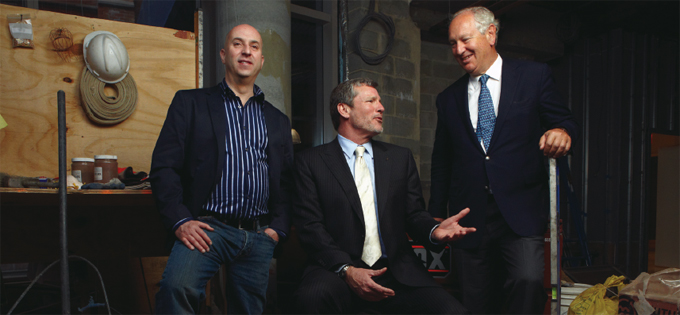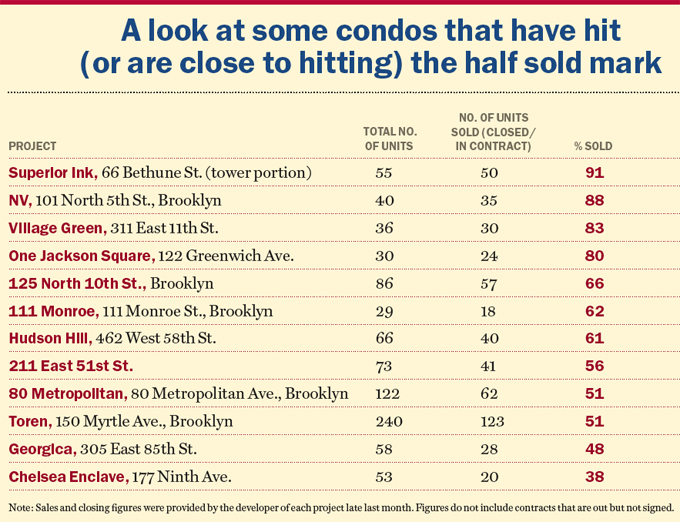Trending
Hitting the magic number
<i>More condos start to reach the 51 percent sold mark, ending catch-22 that has made finding buyers so hard</i>
Fifty-one — as in 51 percent sold — has been the magic number for new condos lately.
Reaching the halfway mark has been a key goal for developers since the beginning of the downturn, when mortgages became elusive in projects with few sales. But it’s an especially important threshold now that more buildings are getting a special Fannie Mae waiver that gives buyers better mortgage rates once 51 percent of the units have been sold. And many buyers, now savvy to these issues, won’t go near a project with a low sales percentage (see chart below).
Last year, 51 percent seemed unattainable for many new residential buildings. But several months of healthy sales activity have now helped a number of condos get there, which has, in turn, led to a further bump in activity as the momentum feeds on itself, experts said.
“Once a property reaches the 50 percent sold mark, velocity can increase dramatically,” said Kelly Kennedy Mack, the president of Corcoran Sunshine Marketing Group.
While 51 may be the magic number, it’s not a magic bullet that can erase all of a project’s problems. These days, a high percentage of units sold must be accompanied by a finished project, or skittish buyers will shy away, brokers said.
Moreover, a building may have a high percentage of units in contract, but if the project has been on the market for several years or few units have closed, many in the industry look askance.
“If a building just came on the market a year ago, you could say it’s selling well in this crisis if it’s 50 percent sold,” said real estate lawyer Luigi Rosabianca. “But if it’s been on the market for four years [and it’s 50 percent sold], you’ve got to ask yourself if there’s a problem.”
In recent months, a number of new developments have reached or surpassed the 51 percent sold mark.
“The market has picked up tremendously over the past seven or eight weeks,” said Kenneth Horn, president of Alchemy Properties and the developer of Hudson Hill Condominium on West 58th Street. He said he’s now selling around two units a week, compared to two a month during the worst of the crisis. Fourteen of his units have sold in the last two months, he said, and 40 of the project’s 66 units — or 61 percent — are now closed or in contract.
Hudson Hill is not alone. For the past year, Rolan Shnayder, director of new development lending at Manhattan-based Home Owners Mortgage, has spent much of his time finding mortgages for buyers in buildings less than 51 percent sold. Now, he said, that’s becoming less and less necessary.
In the past few months, “there were a lot of buildings that went over that benchmark,” Shnayder said.
One Jackson Square, the 30-unit glass tower that’s being marketed by Corcoran Sunshine, reached the halfway point in November. “Once we crossed over that 50 percent mark and started closings, activity more than doubled,” Mack said.
Twenty-four units, or 80 percent of the building, are now sold.
The biggest factor in spurring sales at buildings that have hit the 51 percent target is, of course, financing. While some mortgages are available in buildings with a low sales percentage, the terms are less favorable, and many developers have had to discount units as a result, Shnayder said.
“The fact that we’re more than 80 percent sold is very big for the banks,” said Michael Namer, the developer of Village Green at 311 East 11th Street, where 30 of 36 units have gone into contract since sales started in the spring of 2009. “One of the main things that they’re looking for is over 50 percent sold.”
Accentuating this trend is the fact that more developers have now gone through the elaborate process of getting Fannie Mae approval, explained Shnayder. Fannie Mae guidelines require a new condo to sell or close 71 percent of its units before the agency will back loans in the building. But if a project meets Fannie Mae’s requirements, he said, the developer can apply for a special waiver that lowers that percentage to 51 percent. Banks are then much more willing to underwrite loans in the building, because they know Fannie Mae will insure them.
In the days of easy credit, few city condos bothered to go through the Fannie Mae approval process because banks would lend without it.
Then, when the credit crisis first hit, many developers tried to get the approval but found that the agency kept changing its guidelines.
“The good news is that now Fannie Mae has decided what they’re looking for and what it takes to be an approved building,” said Wayne Heicklin, cochair of the real estate group at Pryor Cashman. “Six months ago, they didn’t know.”
The clear guidelines have allowed developers to get their ducks in a row and has made Fannie Mae approval the new standard.
“Buildings that haven’t done Fannie Mae aren’t looked at [by buyers],” said Douglas Steiner, the developer of 80 Metropolitan in Williamsburg, where 62 out of 122 units, or roughly 51 percent, are now closed or in contract. “Most projects that are complete will have it.”
Reaching the halfway mark is also crucial for luring buyers. At the beginning of the downturn, many would-be buyers seemed blissfully unaware of stringent financing requirements until they tried to get loans. But now they’re hyper-aware — so much so that some brokers “won’t take buyers to buildings that are under 50 percent sold,” Shnayder said.
In fact, buyers watch carefully to see which buildings are nearing the halfway point, and then pounce.
Daniel Brodsky, the developer of Chelsea Enclave, said now that he’s sold nearly 50 percent of the units (a figure that includes five contracts that are currently out to buyers), people who have been visiting the sales office for months are finally buying.
“They’re interested in how many have been sold,” he said. “That builds people’s confidence.”
Of 53 units in the building, 13 sales have closed, seven contracts have been signed and five contracts were out at press time, he said. Three of the deals had been made in a roughly one-week period last month, he said.
The mentality is simple. “When buyers see that others are buying, they’re going to buy,” said David Behin of the Developers Group, which is handling sales at 111 Monroe in Brooklyn, where 18 of the 29 units have gone into contract. He said the development does everything it can to promote the number of units sold.
“We tout it in ads or e-blasts,” Behin said. “Anywhere we can, we say it.”
Buyers’ fixation on the percentage of units sold has intensified now that sales and closing data is more readily available than ever before on sites like StreetEasy.
These sites have “become a pretty potent tool … where in the past it was a mystery how many units had sold,” said James Lansill, a senior managing director at Corcoran Sunshine. As a result, “if you’re not showing sales activity, it can harm your ability to transact.”
Still, reaching the 51 percent sold mark isn’t a panacea.
Consumers these days are hesitant to buy from floor plans, so the number of units sold doesn’t mean much unless a building is virtually complete, according to Andrew Gerringer, managing director of the Prudential Douglas Elliman Development Marketing Group.
“It has to be coupled with a building being built,” Gerringer said. “If a building was sitting there 50 percent sold and no work was being done, people would be very nervous.”
Don Capoccia, the developer of Toren in Downtown Brooklyn, which reached 50 percent sold in December, said removing the sidewalk shed outside the building has helped the project get “more traffic than we did when we went on the market two years ago.”
“If you’re in the market right now, where are you going to put your down payment — a job that’s 30 percent sold, or a job where you know you can close?” said Capoccia, who developed Toren with partners Brandon Baron and Joseph Ferrara.
A high sales percentage can be deceiving, Rosabianca said, especially if the project entered the market long before the Lehman Brothers crash. Another red flag is a large number of units in contract but few closings.
“Just because it’s in contract doesn’t mean it’s going to close,” Rosabianca said.
In late February, for example, buyers at West Soho condominium 22 Renwick were granted the right of rescission after the building experienced construction delays.
Before that, 14 of the 19 units in the building — more than 70 percent — had been in contract.
These days, it takes about three months to close once a certificate of occupancy has been issued. If a building has a large number of units in contract for longer than that, it’s a bad sign, Rosabianca said.
“If you have a building where contracts have been outstanding for a year, you know those people are trying to get out, especially if a certificate of occupancy has been issued,” he said.
Also, if a building has sold more than half of its units but has been on the market for years, it can mean the building is overpriced or otherwise flawed, he said. A developer has to pay common charges on unsold units, so holding them for a long time can be a financial strain, he added.
Still, it’s hard to tell what a developer’s financial standing is. Rosabianca recommends that buyers and their brokers be careful about due diligence.
“The 51 percent mark is just one part of the puzzle,” he said.






